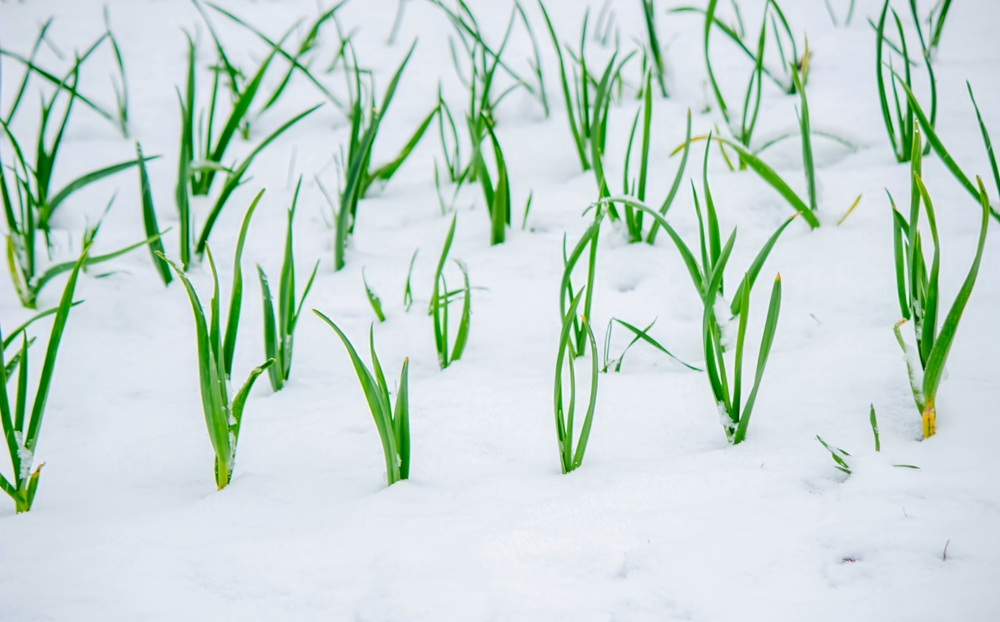
Image Source: Shutterstock.com
The first snow of the season might look magical from your kitchen window, but your raised garden beds? They’re about to face a frosty fight for survival. Beneath that peaceful white blanket, your soil, plants, and hardworking microbes are all scrambling to handle freezing temps, heavy moisture, and winter’s unpredictable mood swings.
The good news is, a little prep work before the first flakes fall can make all the difference between a thriving spring garden and one that wakes up cranky and compacted. So grab your gloves, a hot cup of cocoa, and let’s turn those raised beds into winter warriors.
Clear Out the Spent Plants (But Do It Smartly)
Before the snow hits, your garden needs a deep clean—but not a scorched-earth cleanup. Pull out diseased or pest-infested plants right away; you don’t want overwintering bugs and fungi throwing a party under the snow. However, if you have healthy plant material, don’t toss it just yet. Some dried stems and roots can help prevent soil erosion and give beneficial insects a safe place to hunker down. Think of it as leaving behind cozy guest rooms for your garden’s tiny winter residents while keeping the troublemakers out.
Add a Layer of Nutrient Insurance
Winter may seem quiet, but it’s actually the perfect time to feed your soil. After your cleanup, spread a thick layer of compost across each raised bed. The freeze-thaw cycles of winter will naturally work that organic matter into the soil, enriching it for spring planting. You can also mix in aged manure or leaf mold if you want to give your garden an extra nutritional kick. When the snow melts, you’ll be left with crumbly, nutrient-rich soil that practically begs for seeds.
Mulch Like You Mean It
Mulch isn’t just for summer—it’s your garden’s winter blanket. Once your compost is in, top it with a generous layer of straw, shredded leaves, or wood chips. This helps insulate the soil, regulate temperature, and reduce frost heaving (when soil expands and contracts, pushing roots upward). It also prevents erosion when the snow starts to melt in uneven spurts. Think of it like tucking your raised beds in for a long, cozy nap—they’ll wake up refreshed, not frostbitten.
Protect Perennials and Root Crops
If you’ve got hardy perennials like herbs, garlic, or overwintering root crops, they’ll need a little extra TLC. Cover them with an extra layer of mulch or even a cold frame if you expect heavy snow or fluctuating temperatures. Garlic, for instance, loves a good chill but hates being exposed to freeze-thaw cycles that can damage its developing roots. For more delicate perennials, you can use frost cloth or burlap to create a breathable barrier that traps warmth. With the right protection, your plants can quietly grow stronger all winter long beneath the snow’s surface.

Image Source: Shutterstock.com
Check Drainage Before It’s Buried
Snowmelt can be sneaky—it looks innocent but can wreak havoc if your raised beds don’t drain properly. Before the ground freezes, inspect the edges and bottoms of your beds to make sure water has a way to escape. You don’t want melting snow pooling and turning into an icy swamp that drowns your soil microbes. If necessary, mix in some coarse sand or perlite to improve drainage. A few minutes spent fixing this now could save you a muddy mess (and root rot) come spring.
Cover Crops: The Secret Weapon
If you haven’t tried growing cover crops in your raised beds, winter is the perfect excuse to start. Plants like clover, winter rye, or vetch not only protect your soil from erosion but also add nutrients and organic matter as they decompose. Even if they get flattened by snow, their roots will hold the soil structure intact through all those winter freezes. Plus, cover crops discourage weeds from taking over while everything else is dormant. It’s like having little garden bodyguards working through the cold months while you stay warm indoors.
Don’t Forget the Bed Frames
Raised beds themselves can suffer under snow and ice, especially if they’re made of wood. Check for cracks, warping, or loose joints before the temperature drops too low to fix them. Tighten screws, replace damaged boards, and consider adding corner braces for extra stability. If your beds are metal or composite, give them a quick inspection too—snow weight and moisture can cause subtle damage that worsens over time. A sturdy frame now means fewer repairs and less frustration when spring planting rolls around.
Snow Can Be a Friend (If You Use It Right)
Here’s the fun twist: snow isn’t always the enemy. A moderate snow cover acts like insulation, keeping the soil temperature more stable and protecting roots from deep freezes. The trick is even distribution—if drifts pile up unevenly, they can compact your soil or smother delicate areas. After a big storm, gently redistribute snow across the beds with a rake to avoid heavy buildup in one spot. It might sound quirky, but managing your snow cover can help your raised beds emerge from winter in much better shape.
Winter Watering (Yes, Really)
Even though everything looks frozen, your soil still needs occasional hydration. If you live in a region with dry, windy winters, your raised beds can lose moisture faster than you’d think. Water on warmer days when temperatures rise above freezing to prevent soil from drying out completely. Just don’t overdo it—you’re keeping the soil damp, not soaked. Maintaining moisture balance helps soil microbes stay alive and keeps your structure from becoming brittle or powdery by spring.
Give Tools and Accessories a Winter Home Too
Don’t forget the accessories that make your raised beds shine all season. Remove any trellises, irrigation systems, or decorative stakes before heavy snow hits. Store them somewhere dry and out of direct sunlight to prevent rust and cracking. If you use hoops or row covers, label them for easy reassembly when spring returns. Taking care of these details now saves a lot of scrambling (and cursing) when you’re itching to plant again in a few months.
Give Your Garden a Cozy Winter Break
Prepping raised beds for snowfall isn’t just about protection—it’s about giving your garden a well-deserved rest. With the right mix of cleaning, covering, and caring, you’ll wake up to soil that’s rich, alive, and ready to burst with new life the moment temperatures rise. Winter doesn’t have to be your garden’s off-season—it can be its secret recharge period. A little effort now pays off big when spring rolls around and your plants thank you by growing stronger than ever.
Have any clever winter prep tips or stories from your own raised beds? Share them in the comments below.
You May Also Like…
9 Root Vegetables to Store in Sand This Winter
How Cold Frames Extend More Than Just Lettuce
How Soil Microbes Shift With Cooler Weather
What’s a Frugal Gardener to do in the Snow?
Why Raised Beds Hold Heat Longer in Fall
Leave a Reply